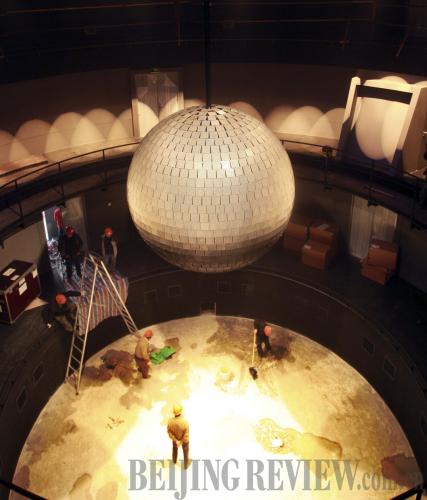|
 |
|
Markus Heinsdorff (COURTESY OF GOETHE-INSTITUT PEKING) |
Markus Heinsdorff, a German installation artist, designed an eco-friendly bamboo exhibit themed Germany and China—Moving Ahead Together inside the official German Pavilion for the 2010 Shanghai World Expo. Beijing Review reporter Wu Yanfei recently interviewed him. Excerpts follow:
Beijing Review: Your small and hut-like design reminds people of Asian aesthetics. What is the role of Asian culture in your work?
Markus Heinsdorff: My work as an installation artist brings together a variety of creative disciplines like architecture, design, photography and sculpture. I experiment with them and bind them together in different ways. I create a new form of art and expression where foreign patterns of culture, especially the cultures of Asia, play a major role.
 |
|
FUTURE CITY: Installers work inside the German Pavilion at the Shanghai World Expo, on March 17 (XINHUA) | As early as 13 years ago, I picked up a cross-cultural topic with my installation Windows—The Dream of Marco Polo. Among other things I used Chinese characters. The installation was presented on locations with strong historical ties to Marco Polo and his travels, like Venice, Italy and Hangzhou, China. Afterward the exhibition that documented the installation on the original sites traveled through many countries.
In many of my works I play with patterns from foreign cultures to create something unique. This is also true for my recent projects through structures made out of bamboo and my approach to subjects like water and tea. Water, tea and bamboo have a lot to do with Asia while they are meaningful to the West as well. I use them to inspire a kind of dialogue between East and West.
Is there any link between your structure made of bamboo and hi-tech material and the official German Pavilion?
I am trying to utilize bamboo as a state-of-the-art material. I started studying the traditional craftsmanship of using bamboo in construction, which I found especially attractive. It is most tempting to rely on bamboo for a modern construction or piece of art. I really want to attract people by opening their eyes about the wide range of ways of using bamboo. In this way I hope to contribute to the very important debate on how to achieve a sustainable future, urbanization and the quest for a livable environment.
The German Pavilion is a very modern construction in a somehow futuristic design. The German-Chinese construction following the theme of Germany and China—Moving Ahead Together is different. Nonetheless, it is to be considered as a kind of supplement to the German Pavilion. Inside the pavilion, visitors will encounter an interpretation of the Expo's motto "Better City, Better Life."
My bamboo construction will be a symbol and message by itself: design and material are meant to function as a kind of guide toward a sustainable future.
Due to the limited space inside our bamboo construction we attempted to create a message for sustainable urbanization that should be perceivable at first sight.
China seeks to build a "harmonious society." What does "harmony" mean to an architect? What do you think is crucial for creating and sustaining harmony and balance in a mega-city like Shanghai?
Artists are in constant need of both harmony and disharmony. Both principles are important for the inner tension of a piece of art.
In Shanghai you can sense it in various ways and circumstances. I think Shanghai is one of the most exciting cities in the world. The city has a very special character, distinctly unique. There is an astounding mixture of harmony and balance. But appearances are often deceptive. There is no doubt something fascinating about the city's neon lights and elevated highways. But I am sure that this does not pave the way to the mega-cities of the future. The same is true of buildings and other structures hastily cobbled together, uninspired and overladen with decoration of dubious taste.
To keep balance means upholding quality in design and material. Urban planning should tend to keep private transport out of town in order to avoid noxious emissions. Free spaces should be readily accessible to people and not wasted for highways or parking lots. Binding together every day's needs of her inhabitants and a salubrious environment in a harmonious way, Shanghai got a fair chance to become a model for future mega-cities.
Are there any examples of modern or traditional Chinese architecture which correspond to your concept of harmony and balance?
There are some Chinese buildings which I am really fond of. Shanghai's landmarks like the new Chinese Pavilion on the Expo grounds, the Oriental Pearl Tower and the traditional teahouse adjacent to the Yuyuan Garden. The Expo pavilion of China's Ningbo City is a very good example of a well balanced modern building with distinctive Chinese features.
Each of these architectural works I mentioned develops its own vernacular in a somewhat peculiar Chinese way. Architecture solidly rooted in its own traditions is very attractive. Western design may provide interesting details but should play a minor role in urban planning in China. In this way Shanghai could maintain her uniqueness instead of losing her charm by constructing mindless functional buildings.
| 